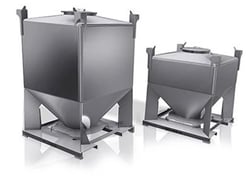In recent years, the world of powder processing has undergone significant changes. With more stringent regulations, rising labour costs and international pressures, there has never been a greater emphasis on production efficiency. Those companies who can produce faster and cheaper without compromising quality will be the ones that thrive. But with more markets demanding smaller volumes of more diversified products, manufacturers know that a process needs to be flexible as well as efficient.
Companies cannot afford to overproduce products and hold excess inventories to meet varying demand.
As a result, philosophies like ‘lean manufacturing’ are being viewed less as a trend and more as the essential method to follow. In this article, we explore how maximising mixer effectiveness using lean production principles is a springboard to more competitive powder processing.
Realise The Value of Your Industrial Mixer
Often the most critical aspect of a powder process and the step where the manufacturer is adding the most value is mixing. With so many different mixing technologies available it can be difficult to decide which provides the best option for lean powder processing. Deciding how best to combine batch or continuous processing, high, low or no shear, horizontal or vertical, the choice is dizzying.
Conventional wisdom would suggest analysing all mixing requirements for a process and simply selecting a mixing system that can do everything. While this approach is fantastic for successful mixing it may not address process efficiency or flexibility. To maximize productivity, key pieces of equipment, like your industrial mixer, need to keep running.
Your productivity is measured by working out the percentage of manufacturing time that is truly productive and is referred to as Overall Equipment Effectiveness (OEE). Simply put, in the case of your industrial mixer, the more it is actually mixing, the higher it's OEE.
Quick isn’t always the fastest
Even if a batch mixing time is only a couple of minutes, it can’t be considered efficient if it takes a significant amount of time to fill or empty the mixer. While steps can be taken to improve mixer filling and emptying times, there are other factors to consider too. For example, the time required to clean the mixer can make product changeovers a time-consuming endeavour, although a necessary requirement. This not only reduces the mixing system’s OEE, but it also limits your facility’s ability to respond to sudden production schedule changes.
Efficient Industrial Mixers
One mixing technology that is capable of achieving a very high OEE is container blending. This approach uses rigid Intermediate Bulk Containers to provide a detachable blending vessel. This means formulation (filling), emptying and cleaning of the IBC is carried out separately from the mixer (parallel processing is all the processing steps working at once, rather than sequentially).
When one batch is blended, simply remove the IBC and replace it with another filled with unmixed materials. A manufacturer can begin to mix the next batch immediately even if changing recipes.
Productivity Improvements
The images below illustrate the differences between the in-line and parallel solutions.
If we imagine a one-tonne batch being produced in both scenarios, we can make a simple cycle time analysis:
- Decanting bags – 20 minutes
- Mixing operation - 10 minutes
- Packing into 25kg bags - 20 minutes.
The first batch-processed will take 50 minutes in both scenarios, however, with the in-line approach, every batch thereafter will also take 50 minutes to process, producing a maximum of nine to ten batches in an eight-hour shift.
By adopting the decoupled parallel approach, the batch cycle time will be dictated by the single longest stage of the process. In a typical cycle, this equates to 20 minutes for decanting and packing. So, after the first batch has run, taking 50 minutes, all subsequent batches will only take 20 minutes to process. 
By using IBCs, suddenly you can produce 21 batches in an eight-hour shift! That’s more than double the throughput and an increase in OEE of over 100% all by making a simple change in your production method.
As a food manufacturer, with lots of different recipes to produce, the efficiency improvements become even more apparent once you take into account the time spent cleaning between recipe changes. In the sequential system, all powder has to be processed before cleaning can begin. With a decoupled system, an operator can start cleaning individual processes as soon as they are complete without having to wait for the subsequent process to finish.
Why Modern Powder Manufacturers Need To Evolve
While there’s no single answer to improve blending productivity, in some cases using multiple mixing technologies can produce a highly efficient and flexible processHigh runners are probably most efficiently produced using in-line, high-speed mixing lines. This works as long as the recipes don’t change very often. In the bakery context, this would be the white loaf. But for the low runners, with high variety of recipes, the key is to remove these extraordinary SKU’s from the line to reduce changeover cleaning times. This is where in-bin blending would come into use. Do this and you’ll achieve outstanding OEE for both lines which is critical in lean powder processing
It’s this kind of shift in thinking that’s required to maximize mixer effectiveness and keep ahead of your competition.
For your food manufacturing operation to be as profitable as possible, investing in the right pieces of kit is key. Take a look at our whitepaper to see how to select the right industrial mixer for you.
Topics:
Blending
